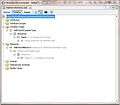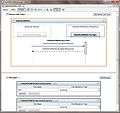OpenESB
| Developer(s) | OpenESB Community, formerly Sun Microsystems |
|---|---|
| Stable release | |
| Written in | Java |
| Operating system | Cross-platform: Windows Mac OS Linux supported |
| Type | Enterprise Service Bus |
| License | CDDL |
| Website | http://www.open-esb.net/ |
OpenESB is a Java-based open source enterprise service bus. It can be used as a platform for both enterprise application integration and service-oriented architecture. OpenESB allows you to integrate legacy systems, external and internal partners and new development in your Business Process. OpenESB is the unique open-source ESB relying on standard JBI (Java Business Integration), XML, XML Schema, WSDL, BPEL and Composite application that provides you with simplicity, efficiency, long-term durability, and savings on your present and future investments with a very low TCO (Total Cost of Ownership).
It used to be owned by Sun Microsystems, but after Oracle and Sun Microsystems merged (see: Sun acquisition by Oracle), the OpenESB Community was created to maintain, improve, promote and support OpenESB.
Architecture
OpenESB consists of 5 parts: the framework, the container, the components,the Integrated Development Environment and the development plugins.
 OpenESB main parts
OpenESB main parts JBI high level schema
JBI high level schema
Framework
The framework consists of a lightweight JBI implementation in Java. This implementation is container-agnostic and can work on any platform and any container. Even if development and support are mainly focused on Glassfish V2 and V3 platforms, beta projects on JBoss and standalone JVM work well and are in progress (2012 Q2). In addition to the OpenESB framework being lightweight, it is also reliable and highly scalable. It is embedded in a Java virtual machine and communicates with other framework instances through Binding components. This architecture matches perfectly with new cloud architectures and allows easy deployment and management on very complex infrastructures. The framework is fully manageable with any JMX-based tool such as Jconsole or more sophisticated tools like Opsview or Nagios.
The framework implements a virtual bus known as the Normalised Message Router (NMR). This is a powerful asynchronous intelligent communication channel between components.
Components
The JBI specification defines 2 component types: The services engine (SE) and the binding component (BC). The SE and BC implement the same interface contract, however, they behave differently:
- Binding components act as the interface between the outside world and the bus, being able to generate bus messages upon receipt of stimuli from an external source, or generate an external action/interaction in response to a message received from the bus.
- Service engines receive messages from the bus and send messages to the bus. SE’s have no direct contact with the outside world. They rely on the bus for interaction with other components, whether binding components or other service engines.
OpenESB includes many Components 'out of the box'.
OpenESB Binding Components
| Binding Component Name | Description | Supported |
|---|---|---|
| HTTP BC | Sends and receives messages through HTTP (get, post,...) | Yes |
| SOAP BC | Sends and receives SOAP messages through HTTP | Yes |
| FTP BC | Sends and receives messages from and to FTP servers | Yes |
| Database BC | Full access to Database through JDBC | Yes |
| JMS BC | Sends and Receives messages from and to JMS Brokers | Yes |
| LDAP BC | Full Access to LDAP server | Yes |
| Email BC | Receives message from POP, IMAP servers and send messages to SMTP server | Yes |
| REST BC | Exposes and Invokes services through REST channel | Yes |
| HL7 BC | Used to communicate with Healthcare applications using the HL7 protocol | Yes |
| TCP/IP BC | Use TCP/IP to send and receive messages | Yes |
| Scheduler BC | Scheduler based on Quartz to trigger any business process | Yes |
| Bespoke BC | You can develop your own Binding component | On demand |
OpenESB Service Engines
| Service Engine Name | Description | Supported |
|---|---|---|
| BPEL SE | Highly scalable orchestrator based on BPEL 2.0. | Yes |
| XSLT SE | Embedded XSLT in Business processes | Yes |
| IEP SE | Intelligent Event Processor | yes |
| POJO SE | Transform any Java class into an OpenESB component | Yes |
| JEE SE | Transform any EJB or Servlet into an OpenESB component | Yes |
| WLM SE | Provides task management and human intervention in a business process | On demand |
| ETL SE | ETL for OpenESB | On demand |
| Bespoke SE | You can develop your own Service engine | Yes |
Integrated Development Environment & Plugins
OpenESB offers a set of graphical tools to ease complex SOA and integration developments. Powerful XLM, XML Schema, WSDL, BPEL editor, data mapping and Composition Applications graphical editors are proposed with OpenESB. Similarly, build, deploy, un-deploy, run, test and debug tasks are managed by graphical tools. OpenESB provides the best ergonomics for ESB and SOA developments.
 XSD Editor
XSD Editor WSDL Editor
WSDL Editor BPEL Editor
BPEL Editor Complex BPEL sample
Complex BPEL sample Data Mapper Editor
Data Mapper Editor Composite Application Editor
Composite Application Editor
Container
At present, OpenESB comes with Glassfish V2 as a container. OpenESB on Glassfish is reliable, easily manageable and very scalable with or without Clusters. A benchmark on a 10 € per day machine on the cloud showed that OpenESB processes more than 10 million complex messages on an elaborate multichannel complex business-to-business process (File, FTP, SOAP, JMS). At the same time, it generates more than 12 million complex messages for external partners.[1] With an extra configuration effort, OpenESB runs on JBoss V4 and V5 and set up for production uses. As of 2012, OpenESB development focused on new containers Glassfish V3-V4, JBoss V7, and OSGI. Next versions were planned for 2013.
 Containers available for OpenESB
Containers available for OpenESB
OpenESB community
The table below lists the web sites and forum managed by OpenESB community
| Web site | Description |
|---|---|
| Community portal | Info, Event Download, Documentation, Blog, Forum... |
| Sources repository | All source code and builds: registration required |
| OpenESB community forum | Technical forum with thousands of posts |
| OpenESB LinkedIn group | Discussions on OpenESB |
See also
- Service-oriented architecture (SOA)
- Service Component Architecture (SCA)
- Apache Camel
- Apache CXF
- System integration
- Enterprise Service Bus
- Enterprise Integration Patterns
- Event-driven SOA
- eclipse sirius - Free and GPL eclipse tool to build your own arbitrary complex military grade modeling tools on one hour
- eclipse SCA Tools - Gnu free composite tool
- Free GPL obeodesigner made with eclipse sirius
References
- ↑ "Report: Benchmark Glassfish-ESB April 2010.pdf" (PDF). www.pymma.com. Retrieved 2016-09-26.
External links
- OpenESB project
- LogiCoy OpenESB Development, Consulting and Global 24x7 Support
- Pymma consulting OpenESB consulting, training, architecture design and development
- Neva OpenESB openESB consulting and development
- AT Consulting OpenESB Architecture Design, Consulting, Implementation, Development and Support
- Youtube - NetBeans Open ESB SOA Tools, Composite Application, CASA
- Quick Start Guide to the NetBeans Open ESB CASA Editor
- https://soa.netbeans.org/
- Running Apache Camel in OpenESB